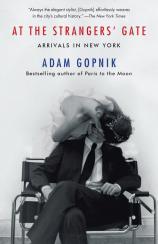At the Strangers' Gate: Arrivals in New York
Review
At the Strangers' Gate: Arrivals in New York
For anyone whose memory of New York in the 1980s turns instinctively to thoughts of Wall Street excess, symbolized in fictional corporate raider Gordon Gekko’s mantra, “Greed is good,” or to a city infested with crime and violence, longtime New Yorker staff writer Adam Gopnik’s AT THE STRANGERS’ GATE will serve as a refreshing corrective. Chronicling the first decade he and his wife, Martha Parker --- fresh from comparatively sedate Montreal --- spent in the city that has been their home for more than 30 years, the 11 loosely connected essays that compose the book display the polymath Gopnik’s breadth of knowledge, graceful prose and a self-deprecating wit that makes it easy to identify with the young couple as they take the first tentative steps toward maturity in their adopted city.
Like many New York stories, the Gopniks’ has much to do with real estate, in their case the two apartments they inhabited after arriving by bus in August 1980. The first, a 9-by-11 basement apartment on 87th Street near First Avenue, that Gopnik dubbed the “Blue Room” (after a Rodgers and Hart song) was so small he never felt as if he got a good look at Martha while they lived there. It was noteworthy, not merely for its minuscule size, but also for the "entomological laboratory" of cockroaches that shared it with them. Though the loft they rented in 1983 seemed infinitely more spacious, the vermin that infested it (first mice and then rats) only became larger.
"Gopnik doesn’t try to glamorize the first decade he and Martha spent in New York City, but it’s impossible to read this appealing book without appreciating it as the opening chapter of a love affair with a place that, for Gopnik and his wife, will endure as long as they live."
Gopnik, who came to New York to attend graduate school in art history at NYU (Martha, a documentary filmmaker, enrolled at Columbia), makes it clear he did not emerge, fully formed, as the erudite writer who’s equally impressive whether he's discoursing on Charles Darwin, Buddhist meditation or baseball. Confessing his desire to become “some odd amalgam of E.B. White and Lorenz Hart, writing wry essays with one hand and witty lyrics with the other,” Gopnik’s road to his coveted spot at The New Yorker was much more prosaic. It included six years’ worth of rejections of proposed “Talk of the Town” pieces until his first one was accepted in 1986. The undistinguished employment history that preceded it included stints as the fashion copy editor at Gentlemen's Quarterly (before it was known as GQ)and a job at the Museum of Modern Art, where he was paid $150 per week for three impromptu lunchtime lectures to often surprised patrons on famous works of art.
Along the way, Gopnik had the good fortune to cross paths with famed photographer Richard Avedon, who became for him a “charismatic pseudo-parent” after they met in 1985. “Men Making Pictures of Women Wearing Clothes” is a mini-profile of Avedon and a warmhearted tribute to a friendship that endured until the photographer’s death in 2004. Though their relationships weren’t nearly as close, Gopnik also offers candid glimpses of the controversial art critic Robert Hughes, and Joseph Mitchell, most famous for his piece “Joe Gould’s Secret,” and for the fact that he spent the last 32 years of his career reporting to work daily at The New Yorker without producing another published piece.
If there’s any weakness in AT THE STRANGERS’ GATE, unfortunately, it’s the book’s longest piece, “SoHo, 1983.” The selection starts promisingly, with the story of the Gopniks’ good fortune in landing a 1,500-square-foot loft for the “staggeringly reasonable monthly rent” of $832 and a description of the neighborhood’s emergence as the home of New York’s avant garde art scene in the 1980s. Readers who aren’t familiar with the minutiae of debates that roiled the art world during this era may find their attention wandering, as Gopnik, somewhat sheepishly, acknowledges that he's led them into “dense thickets of art theory."
Sprinkled through the book, Gopnik offers a generous album’s worth of snapshots of the life he shared with Martha, united in "an attitude toward life that didn't take practicalities too seriously," one he calls "materialistic without being at all realistic." In an example of Gopnik's verbal agility, the loss of the pair of pants that was half of the first suit he purchased in New York becomes a metaphor for the way he says he has been "walking with my pants at my spiritual, or anyway narrative, ankles ever since." He possesses a gift for making New York’s neighborhoods come alive, most notably in the essay “Wanderings,” which links his love for traversing their streets on foot with famous predecessors like Walt Whitman and Alfred Kazin.
By the end of the decade, the Gopniks were ready to enter the world of parenthood, aspects of which became the subject of his memoirs PARIS TO THE MOON and THROUGH THE CHILDREN'S GATE. Gopnik doesn’t try to glamorize the first decade he and Martha spent in New York City, but it’s impossible to read this appealing book without appreciating it as the opening chapter of a love affair with a place that, for Gopnik and his wife, will endure as long as they live.
Reviewed by Harvey Freedenberg on September 15, 2017
At the Strangers' Gate: Arrivals in New York
- Publication Date: July 31, 2018
- Genres: Memoir, Nonfiction
- Paperback: 272 pages
- Publisher: Vintage
- ISBN-10: 1400075742
- ISBN-13: 9781400075744










